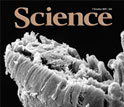News Release 11-215
Crab Pulsar Emits Light at Higher Energies Than Expected
Detection defies current pulsar models, leads to new theories

Crab Pulsar emits light energy above one hundred thousand million electron volts.
October 6, 2011
This material is available primarily for archival purposes. Telephone numbers or other contact information may be out of date; please see current contact information at media contacts.
Pulsars--highly magnetized, rotating stars--were first discovered more than 40 years ago, and are now believed to be a type of stellar leftover, or remnant--in this case, a neutron star--that results from the explosion and gravitational collapse of a more massive star. In the October 7 issue of Science, astrophysicists with VERITAS report an unexpected finding in the Crab Pulsar, which is the central star in the Crab Nebula in the constellation of Taurus. They detected pulsed gamma rays, or light energy, above one hundred thousand million electron volts. The detection cannot be explained with current pulsar models that show pulsed gamma rays in the range of a few hundred million electron volts to a few thousand million electron volts. The finding is causing researchers to consider new theories about gamma-ray production. More on the discovery can be found in press releases by the Harvard-Smithsonian Center for Astrophysics, University of California, Los Angeles, University of California, Santa Cruz and others. The paper, online in Science today, had 95 coauthors, including scientists from 26 institutions in five countries, who are part of the VERITAS collaboration.
Left is an artist's conception of the VERITAS array of imaging atmospheric Cherenkov telescopes (IACTs) observing the Crab Nebula. IACTs detect high-energy gamma-rays. Also seen is a very high energy gamma-ray originating from the Crab Nebula producing an airshower in the high atmopshere. The telescopes observe the Cherenkov radiation produced by the energetic electrons in the airshower. Right is an artist's conception of the pulsar at the center of the Crab Nebula, with a Hubble Space Telescope photo of the nebula in the background.
VERITAS, or Very Energetic Radiation Imaging Telescope Array System, is a ground-based observatory for gamma-ray astronomy located at the Fred Lawrence Whipple Observatory in southern Arizona. It is operated by a collaboration of more than 100 scientists from 22 different institutions in the United States, Ireland, England and Canada. VERITAS is funded by the U.S. National Science Foundation, U.S. Department of Energy Office of Science, Smithsonian Institution, Natural Sciences and Engineering Research Council of Canada, Science Foundation Ireland, and Science and Technology Facilities Council of the United Kingdom.
-NSF-
-
The researchers' work is described in the October 7, 2011 issue of the journal Science.
Credit and Larger Version
Media Contacts
Bobbie Mixon, NSF, (703) 292-8070, email: bmixon@nsf.gov
Lisa Van Pay, NSF, (703) 292-8796, email: lvanpay@nsf.gov
Program Contacts
James Whitmore, NSF, (703) 292-8908, email: jwhitmor@nsf.gov
Co-Investigators
Rene Ong, University of California, Los Angeles, (310) 825-3622, email: rene@astro.ucla.edu
The U.S. National Science Foundation propels the nation forward by advancing fundamental research in all fields of science and engineering. NSF supports research and people by providing facilities, instruments and funding to support their ingenuity and sustain the U.S. as a global leader in research and innovation. With a fiscal year 2023 budget of $9.5 billion, NSF funds reach all 50 states through grants to nearly 2,000 colleges, universities and institutions. Each year, NSF receives more than 40,000 competitive proposals and makes about 11,000 new awards. Those awards include support for cooperative research with industry, Arctic and Antarctic research and operations, and U.S. participation in international scientific efforts.
Connect with us online
NSF website: nsf.gov
NSF News: nsf.gov/news
For News Media: nsf.gov/news/newsroom
Statistics: nsf.gov/statistics/
Awards database: nsf.gov/awardsearch/
Follow us on social
Twitter: twitter.com/NSF
Facebook: facebook.com/US.NSF
Instagram: instagram.com/nsfgov



